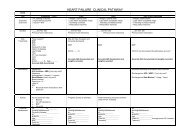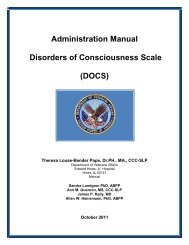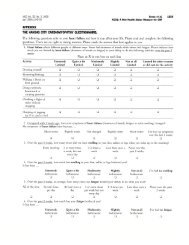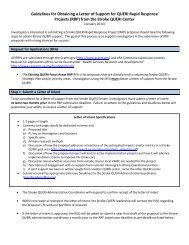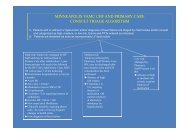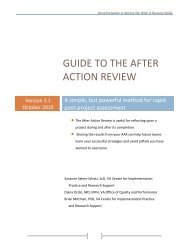The Veteran Supported Education Service Treatment Manual: VetSEd
The Veteran Supported Education Service Treatment Manual: VetSEd
The Veteran Supported Education Service Treatment Manual: VetSEd
You also want an ePaper? Increase the reach of your titles
YUMPU automatically turns print PDFs into web optimized ePapers that Google loves.
PART TWO: TRAINING MANUAL FOR PEER <strong>VetSEd</strong> PROVIDERS & CLINICAL<br />
SUPERVISORS<br />
I. INTRODUCTION TO PART TWO<br />
<strong>The</strong> Training <strong>Manual</strong> has been designed for the peer <strong>VetSEd</strong> provider and clinical<br />
supervisor. It provides structure and guidelines for delivering the <strong>VetSEd</strong> service along<br />
with training exercises and case examples. In this Part, detailed guidance is provided in 7<br />
Sections.<br />
<strong>The</strong> first four sections cover the central <strong>VetSEd</strong> process - Choose, Get, and Keep<br />
respectively. Section Five reviews the core function of the peer <strong>VetSEd</strong> provider, i.e.,<br />
involving and engaging stakeholders or key players in the <strong>VetSEd</strong> approach. <strong>The</strong>se key<br />
players include the <strong>Veteran</strong>, his/her family and friends, clinicians, and educational<br />
personnel. Section Six reviews core competencies that the peer <strong>VetSEd</strong> provider should<br />
have. <strong>The</strong>se core competencies are meant to be applied throughout the <strong>VetSEd</strong> process<br />
and include: solving recovery orientation, appropriate and effective self, counseling<br />
skills, and understanding of the population being served. Please note that the guidelines<br />
for service delivery presented throughout the Training <strong>Manual</strong> incorporate and reflect the<br />
key characteristics described in the overview in Part One. To understand why these key<br />
features are used please refer to the description in Part One. Additionally, worksheets that<br />
accompany these guidelines have been compiled for your convenience in Part Two,<br />
Section Seven. Worksheets are meant to be filled out by the <strong>Veteran</strong> in the company of,<br />
or with support from the <strong>VetSEd</strong> provider. <strong>The</strong>y help to guide the process or to identify<br />
particular areas of need. Worksheets can be copied by the peer <strong>VetSEd</strong> provider for<br />
multiple <strong>Veteran</strong>s.<br />
II.<br />
THE CHOOSE PHASE OF <strong>VetSEd</strong><br />
During the Choose phase of <strong>VetSEd</strong>, you are helping <strong>Veteran</strong>s with those activities that<br />
are necessary for beginning school. As the name implies, this phase is guided by <strong>Veteran</strong><br />
choice. Although you will be guiding and assisting <strong>Veteran</strong>s in choosing appropriate<br />
activities that facilitate achieving their educational goals, ultimately, the choice always<br />
belongs to the <strong>Veteran</strong>. During the Choose phase, your primary role will be to assist the<br />
<strong>Veteran</strong> in creating an educational plan or roadmap that includes necessary steps to begin<br />
and complete school. For example, activities during the Choose phase of <strong>VetSEd</strong><br />
include: internet searches of schools and programs, arranging campus tours, meeting with<br />
26 | P a g e



